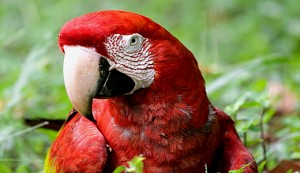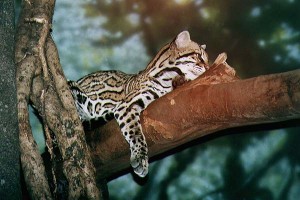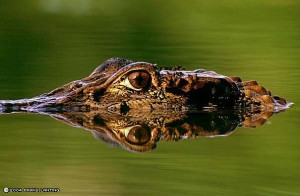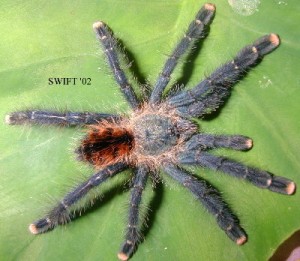This article is written by Manoj Radhakrishnan, an engineer and a travel photographer & writer based in Pune
On our last morning in Cusco, the group formally split and after a tearful farewell, four of us – Bedfords, Mike and yours truly – found ourselves heading towards Puerto Maldonado to spend a few days in the Amazon jungle. Puerto was built during the heights of gold rush and thanks to the mining, this place has the highest mercury poisoning in the world. A three hour boat ride from the airport took us to our destination, Explorers Inn, situated in the middle of the Tambopata Wildlife Reserve. We were welcomed by hot sticky weather, a battalion of butterflies and an army of mosquitos. Explorers Inn is a fantastic place for naturalists who stay here collecting vast quantities of data for their research. Our guide was one such naturalist, Nicole, who had an excellent knowledge of the jungle.
 A macaw at The Tambopata Wildlife Reserve
A macaw at The Tambopata Wildlife Reserve
One of the best places to watch bird life in the jungle are the clay licks (or clay mounds) found along the rivers. Once in every two/three days lots of birds, especially the parrots, come to these mounds to feed on the clay. They do this either to neutralise their acidic diet or to remove toxins from their body or to get some vital minerals – the exact reason is still unknown. The howler monkeys (they sound like 50 pressure cookers) ensure that entire forest wakes up by 5 in the morning, which infact gave us enough time to get into the hide to watch the parrots feed on clay – an absolutely unique sight, I must admit. Another place to watch the parrots feed are the Amasisi trees which can be recognised by their bright red flowers – one of the favourite foods for the parrots and the macaws. The bark of this tree is used extensively for treating eye infections.
We spent rest of the morning visiting the local village, popularly knows as the infernos. These infernos were created when the Andean people, attracted by its greenery, came down to the jungle to pursue agriculture. What they did not realise is that, for all its greenery, the jungle has one of the poorest soils in the world. It is the constant decaying top layer which provides the much needed nutrients to sustain the jungle. Clearing the jungle for cultivation stops this process and thereby makes the land useless for the future. In fact a piece of land takes about 20 years to recover from a year of cultivation! The disappointment of the initial settlers when they learnt this fact is reflected in the name : the infernos. Despite this fact, there are a few papaya and banana plantations which support the people in these villages. Among the things we ate, my favourites were the cocona, a tomato like fruit, and the chocolate – for the first time in my life, I was seeing chocolates grow on trees! The wild cats in the jungle are always in grave danger from these village people. If any of the cats poses any threat to the livestock, its days are numbered. One of the locals working in the village hospital showed us a freshly killed ocelot’s skin. It was a sad sight especially when we know that the naturalists on the other side of the river are spending months following their footsteps trying their best to study these nocturnal creatures.
 An Ocelot kitten resting on a tree
An Ocelot kitten resting on a tree
The poor quality by of the soil combined with the struggle for the sunlight have created some unique adaptations amongst the plants/trees in the jungle, the best example of which is the tree known as the walking palm. The tree is capable of sending new roots towards regions rich in nutrients and severing the old ones, thereby actually “walking” to the food rich locations. A typical walking palm walks upto 40cms in its life time. The strangler fig, in order to maximise the sunlight it receives, starts its growth top down from the top branches of a host tree. When the fig becomes self supporting, it kills the host tree by cutting off its sunlight. The trees such as the capirone sheds its bark continuously to get rid of the climbers so that they can photosynthesise through their trunk. There are also trees like the tangorona tree which achieves their goal by hosting a certain species of ants called the fire ants. These ants feed on the nearby vegetation and ensure that no other tree can grow in the vicinity of their host!
 A Black Caiman wading through a jungle lake
A Black Caiman wading through a jungle lake
After dinner time was usually spent looking for tarantulas and caimans. The caiman search was done under bright moonlight using an additional searchlight. Although we did manage to spot a few, we all enjoyed the boat ride more than the search. During one of the days, we also had a futile search for the giant Amazonian otters in the biggest lake of the area, Cocacocha. Although we did not see the otters, we were happy to see a few hoatzins, the national bird of Guyana and also the only bird that has a foregut for fermentation – like a cow, and a few pretty Amazonian butterflies which were flying around us to feed on the salts from our sweat. Tambopata was also the place where I discovered the bird watcher in me. Free afternoons with all the jungle sounds brainwashed me into believing that I can also start recognising the calls of the birds just like the locals and the naturalists. Well, with about 1000 different species and with birds such as cecique, which can imitate 100 other birds, my goal wasn’t easy to achieve. In the end I am happy that I could recognise the few obvious ones like the screaming peehaws – which spents 85% of its life calling for its mate – and the macaws.
Although I spent lesser days in the jungle compared to the desert and the mountains, I enjoyed the stay here as much, if not better, than the other two regions. After a few more flight journeys, few more farewell hugs and a few more last suppers, I was back in reality… back in LA. Only the photographs and the occasional email from the east are stopping me from concluding that those 25 days, when the time stood still, was not a dream.
Manoj Radhakrishnan
http://www.travel-notes.org/amazon.html
